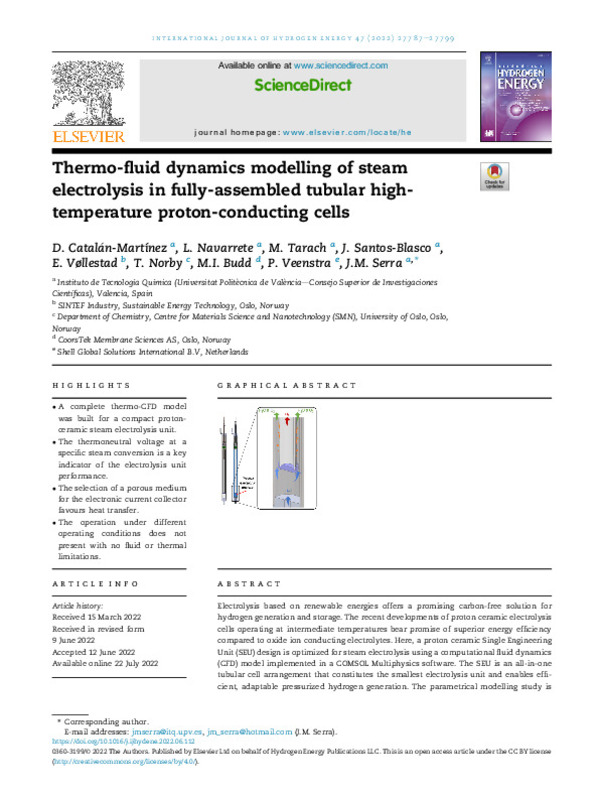JavaScript is disabled for your browser. Some features of this site may not work without it.
Buscar en RiuNet
Listar
Mi cuenta
Estadísticas
Ayuda RiuNet
Admin. UPV
Thermo-fluid dynamics modelling of steam electrolysis in fully-assembled tubular high-temperature proton-conducting cells
Mostrar el registro sencillo del ítem
Ficheros en el ítem
| dc.contributor.author | Catalán-Martínez, David
|
es_ES |
| dc.contributor.author | Navarrete Algaba, Laura
|
es_ES |
| dc.contributor.author | Tarach, Mateusz
|
es_ES |
| dc.contributor.author | Santos-Blasco, J.
|
es_ES |
| dc.contributor.author | Vøllestad, E.
|
es_ES |
| dc.contributor.author | Norby, T.
|
es_ES |
| dc.contributor.author | Budd, M.I.
|
es_ES |
| dc.contributor.author | Veenstra, P.
|
es_ES |
| dc.contributor.author | Serra Alfaro, José Manuel
|
es_ES |
| dc.date.accessioned | 2023-06-21T18:01:42Z | |
| dc.date.available | 2023-06-21T18:01:42Z | |
| dc.date.issued | 2022-07-30 | es_ES |
| dc.identifier.issn | 0360-3199 | es_ES |
| dc.identifier.uri | http://hdl.handle.net/10251/194459 | |
| dc.description.abstract | [EN] Electrolysis based on renewable energies offers a promising carbon-free solution for hydrogen generation and storage. The recent developments of proton ceramic electrolysis cells operating at intermediate temperatures bear promise of superior energy efficiency compared to oxide ion conducting electrolytes. Here, a proton ceramic Single Engineering Unit (SEU) design is optimized for steam electrolysis using a computational fluid dynamics (CFD) model implemented in a COMSOL Multiphysics software. The SEU is an all-in-one tubular cell arrangement that constitutes the smallest electrolysis unit and enables efficient, adaptable pressurized hydrogen generation. The parametrical modelling study is conducted for two adiabatic operation scenarios with distinct steam conversion rates and tested for multiple key parameters, namely internal and external chamber pressures and inlet stream temperature. The modelling results show that low steam conversions enable operation at higher current densities and that the thermoneutral voltage for a fixed steam conversion is highly sensitive to the process conditions and operation modes. The increment of the pressure of the generated hydrogen implies a reduced production rate at thermoneutral voltage, although it can be compensated with an enhanced steam pressure or a reduced inlet temperature. Additionally, the introduction of a porous medium as the SEU current collector in the steam chamber enhances heat transport within this chamber. The area specific resistance of the system determines the current density, enforcing an adaption of the area of the electrolyser to satisfy the target hydrogen production and energy efficiency. The resulting proposed SEU design and adapted operational parameters allow effective delivery of pressurized dry hydrogen for a wide range of conditions and applications | es_ES |
| dc.description.sponsorship | The work leading to these results has received funding from Spanish Government (RTI2018-102161 grant) and from Fuel Cells and Hydrogen 2 Joint Undertaking under grant agreement 779486 (`GAMER'). This Joint Undertaking receives support from the European Union's Horizon 2020 research and innovation programme, Hydrogen Europe and Hydrogen Europe research. | es_ES |
| dc.language | Inglés | es_ES |
| dc.publisher | Elsevier | es_ES |
| dc.relation.ispartof | International Journal of Hydrogen Energy | es_ES |
| dc.rights | Reconocimiento (by) | es_ES |
| dc.subject | Ceramic proton conductor | es_ES |
| dc.subject | CFD | es_ES |
| dc.subject | Tubular cell | es_ES |
| dc.subject | Water electrolysis | es_ES |
| dc.subject | Modelling | es_ES |
| dc.title | Thermo-fluid dynamics modelling of steam electrolysis in fully-assembled tubular high-temperature proton-conducting cells | es_ES |
| dc.type | Artículo | es_ES |
| dc.identifier.doi | 10.1016/j.ijhydene.2022.06.112 | es_ES |
| dc.relation.projectID | info:eu-repo/grantAgreement/AEI/Plan Estatal de Investigación Científica y Técnica y de Innovación 2017-2020/RTI2018-102161-B-I00/ES/CONVERSION DIRECTA DE CO2 EN PORTADORES DE ENERGIA QUIMICA UTILIZANDO REACTORES ELECTROCATALITICOS DE MEMBRANA/ | es_ES |
| dc.relation.projectID | info:eu-repo/grantAgreement/EC/H2020/779486/EU | es_ES |
| dc.rights.accessRights | Abierto | es_ES |
| dc.description.bibliographicCitation | Catalán-Martínez, D.; Navarrete Algaba, L.; Tarach, M.; Santos-Blasco, J.; Vøllestad, E.; Norby, T.; Budd, M.... (2022). Thermo-fluid dynamics modelling of steam electrolysis in fully-assembled tubular high-temperature proton-conducting cells. International Journal of Hydrogen Energy. 47(65):27787-27799. https://doi.org/10.1016/j.ijhydene.2022.06.112 | es_ES |
| dc.description.accrualMethod | S | es_ES |
| dc.relation.publisherversion | https://doi.org/10.1016/j.ijhydene.2022.06.112 | es_ES |
| dc.description.upvformatpinicio | 27787 | es_ES |
| dc.description.upvformatpfin | 27799 | es_ES |
| dc.type.version | info:eu-repo/semantics/publishedVersion | es_ES |
| dc.description.volume | 47 | es_ES |
| dc.description.issue | 65 | es_ES |
| dc.relation.pasarela | S\488198 | es_ES |
| dc.contributor.funder | European Commission | es_ES |
| dc.contributor.funder | Ministerio de Economía y Competitividad | es_ES |
| dc.contributor.funder | Universitat Politècnica de València | es_ES |








